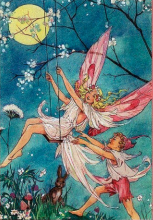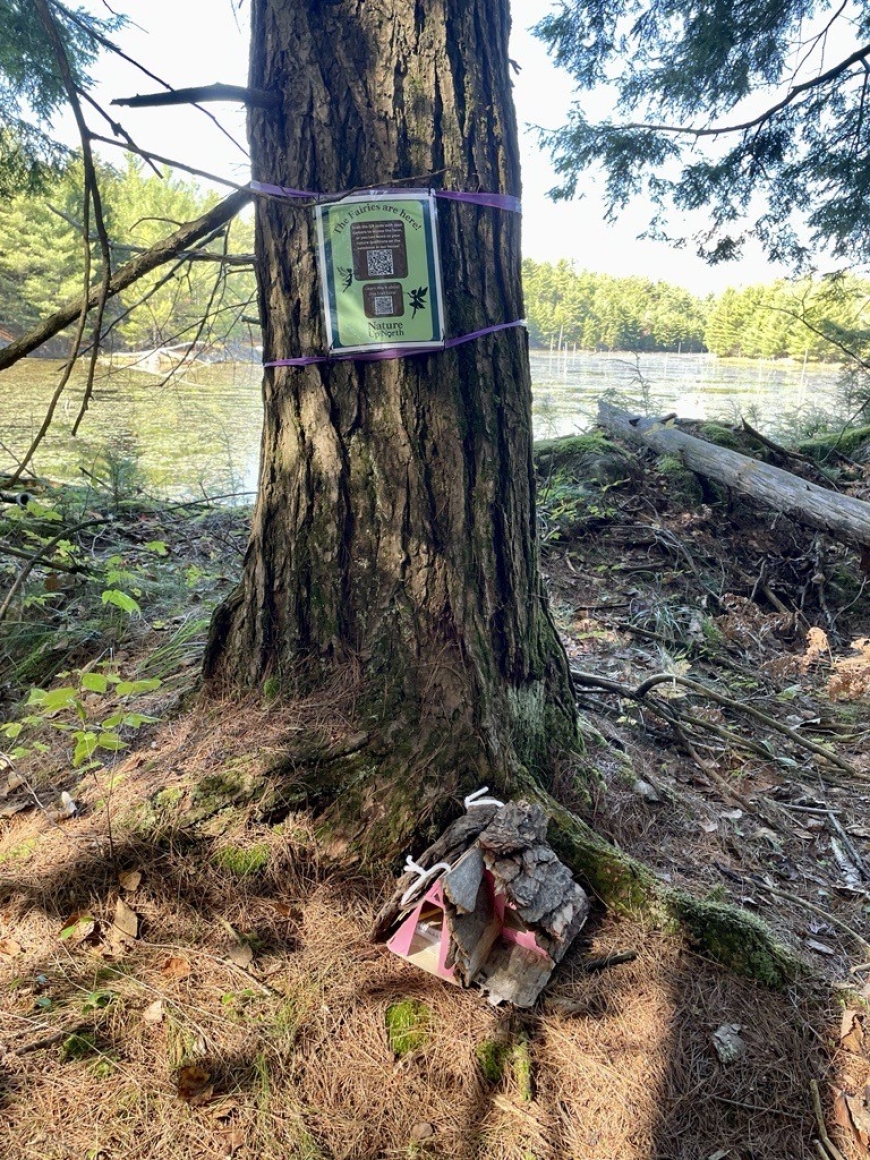
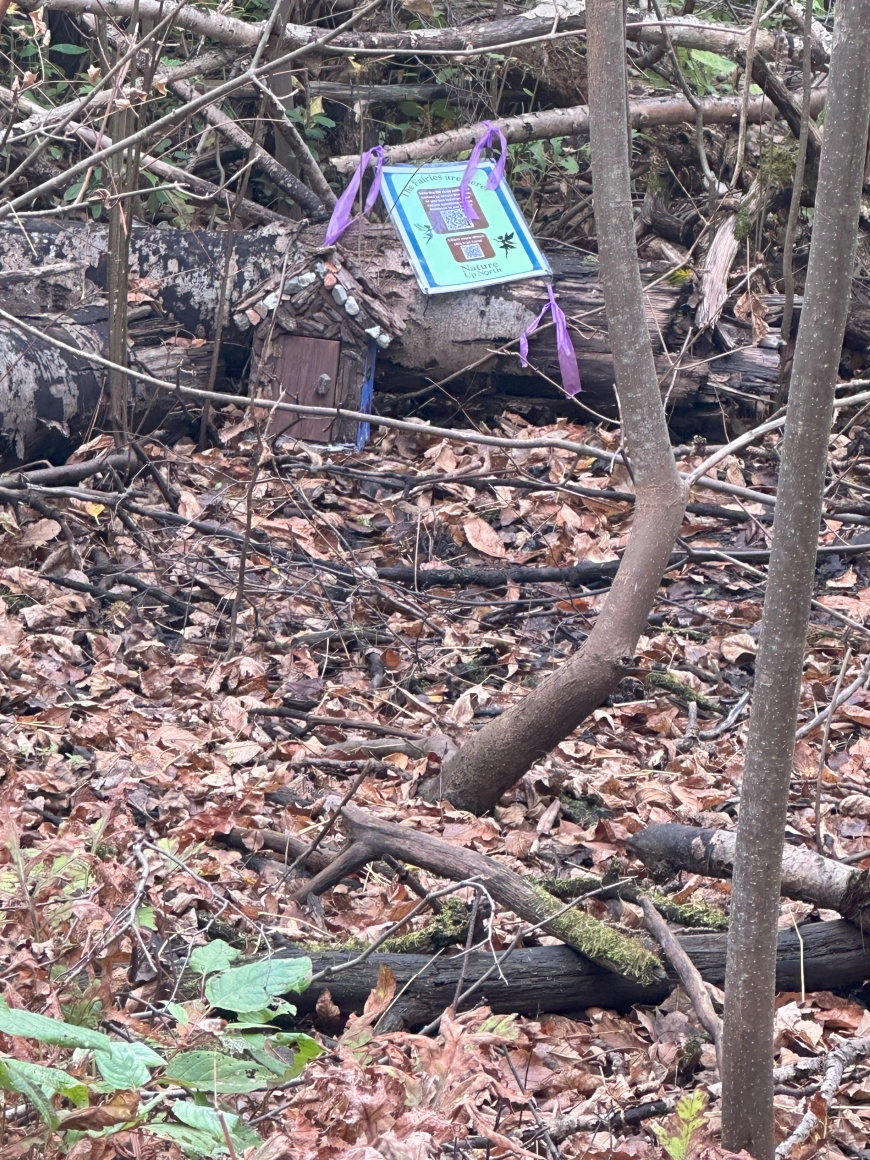
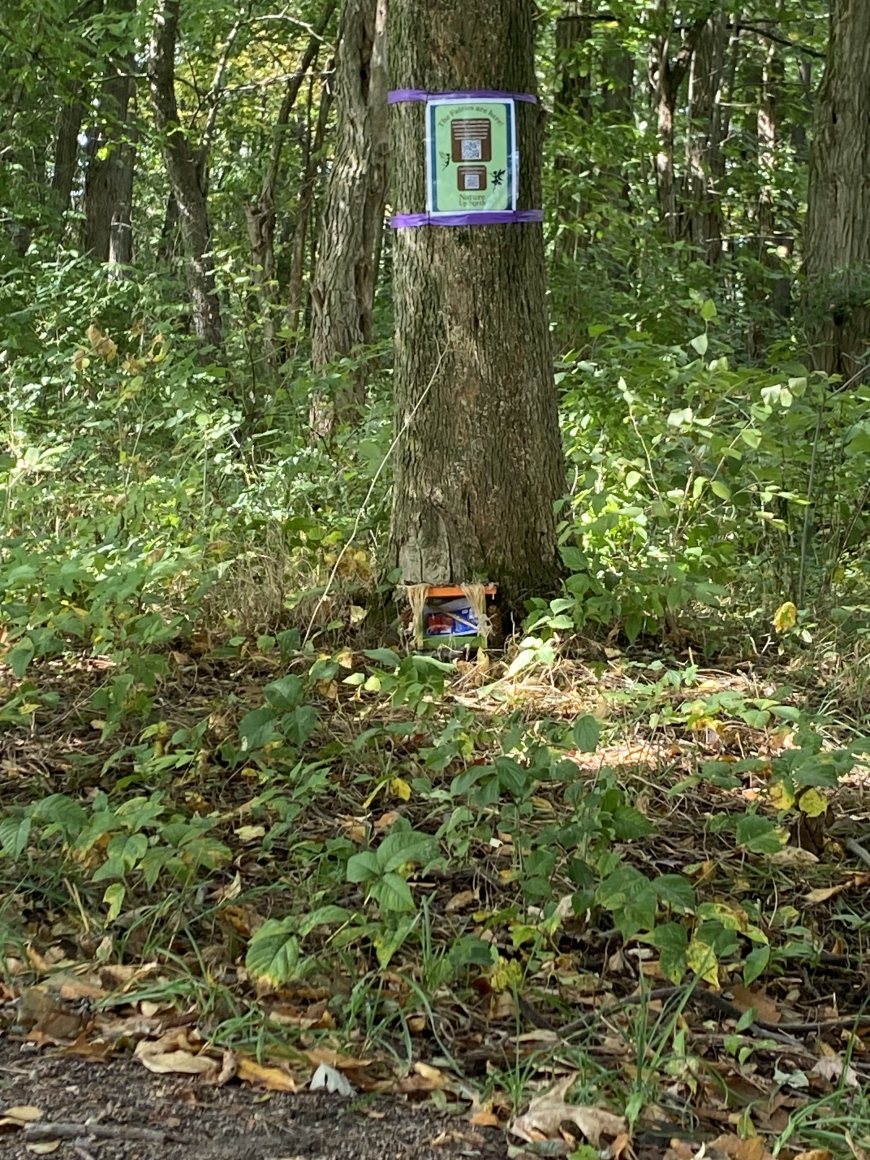



Ask a Fairy: Fall 2024 Answers
Thimble and Blossom let us know that they loved all of the nature questions you had for them this year, and were thrilled to receive a selfie too! Although it was a warm fall and they were able to enjoy the North Country into November this year, they had to continue south in search of warmer climates for the winter. Before they left, they took a moment to write their answers down and share them with us! They loved how curious you all were about nature and yourselves, and they hope you keep exploring the outdoors while they're gone.
Gia, 4, How many bears live around here?
Great question Gia! We talked with a black bear friend of ours and they said that they have about 7000 family members in New York State! Locally though, they’re harder to find because of all the wilderness and habitat they have available. There are sightings every year like this encounter on Nature Up North’s website, and each spring a family of bears usually visits St. Lawrence University’s golf course. If you want to look at more pictures of bears, you can also see trail camera pictures Nature Up North took here!
Dan, 21, Do you ride woodland animals like frogs, squirrels, chipmunks, or others?
We love making friends with all of the animals in the woods! We hitch a ride with frogs to get across wetlands, squirrels to climb the trees, and chipmunks to find cozy places to sleep. Sometimes they're too busy to give us a ride, or too tired from looking for food or playing with their friends, so we will also fly where we need to go when we need to!
Taylor, 9, What happens to the fish when the water freezes?
Hi Taylor, what a great question! Fish have a very clever way of surviving the cold winters. Just like how humans enjoy snuggling up during cold days, fish do the same. They travel to the bottom of the lake and become less active and the ice on top helps keep the deep water warmer! Just like the walls of our homes keep the cold air out and the warm air in, ice keeps the water away from the cold air above, which keeps it warmer. Super funky right?
Amelia, What are you doing for Christmas?
Us fairies are traveling south for the colder months where we will celebrate Christmas with palm trees instead of evergreen trees, which you see in the North Country. But, don’t worry, we’ll be back in the spring!
Ivy, Dakota, and Nova, 4, 9 and 3, What's your favorite food?
Hi Ivy, Dakota, and Nova, what a delicious question! As of now, our favorite food is blueberries. When we have been flying for a while, we like to take a break and eat some or even bring some on our journey to make a blueberry soup for the evening. We are always careful to make sure they’re blueberries and not any lookalike berries that might be poisonous! You should always be 100% sure you know what a plant is before you eat it!
Anonymous, What is the white fluffy stuff on the bottom of some branches in fall?
Hmmm, this is a good question! We’re not too sure on the answer without seeing it with our own eyes. You could be seeing some type of fungus or disease that’s impacting the tree. You can find many pictures of fungi in the North Country on the encounters page of the Nature Up North website, as well as blogs and podcasts created on the topic. This podcast, called Fungi and Trees: Tree Intelligence and Communication, might interest you! It might also be an invasive species called the Hemlock Wooly Adelgid. It's not been confirmed in the North Country yet, but we do see it as we fly south through the southern Adirondacks and along the east coast.
Katie, 31, When did you first appear?
Hi Katie! Our family and descendants have lived in this area for as long as we can remember! We noticed how much the people involved with Nature Up North and the North Country cared about the local environment and decided we wanted to build a deeper connection with them to share our knowledge and love for the North Country ecosystems. You can learn more about the mission of Nature Up North at the link here!
Evan and Libby, 21, How do you find connection with the earth?
Hi Evan and Libby! We find connection with the earth by learning more about and appreciating all the fascinating creatures that call Earth home. Spending mindful time outside in nature brings us such joy and connection! Take care to notice the small details and be intentional when you go for walks, drive through the countryside, and when you explore in general!
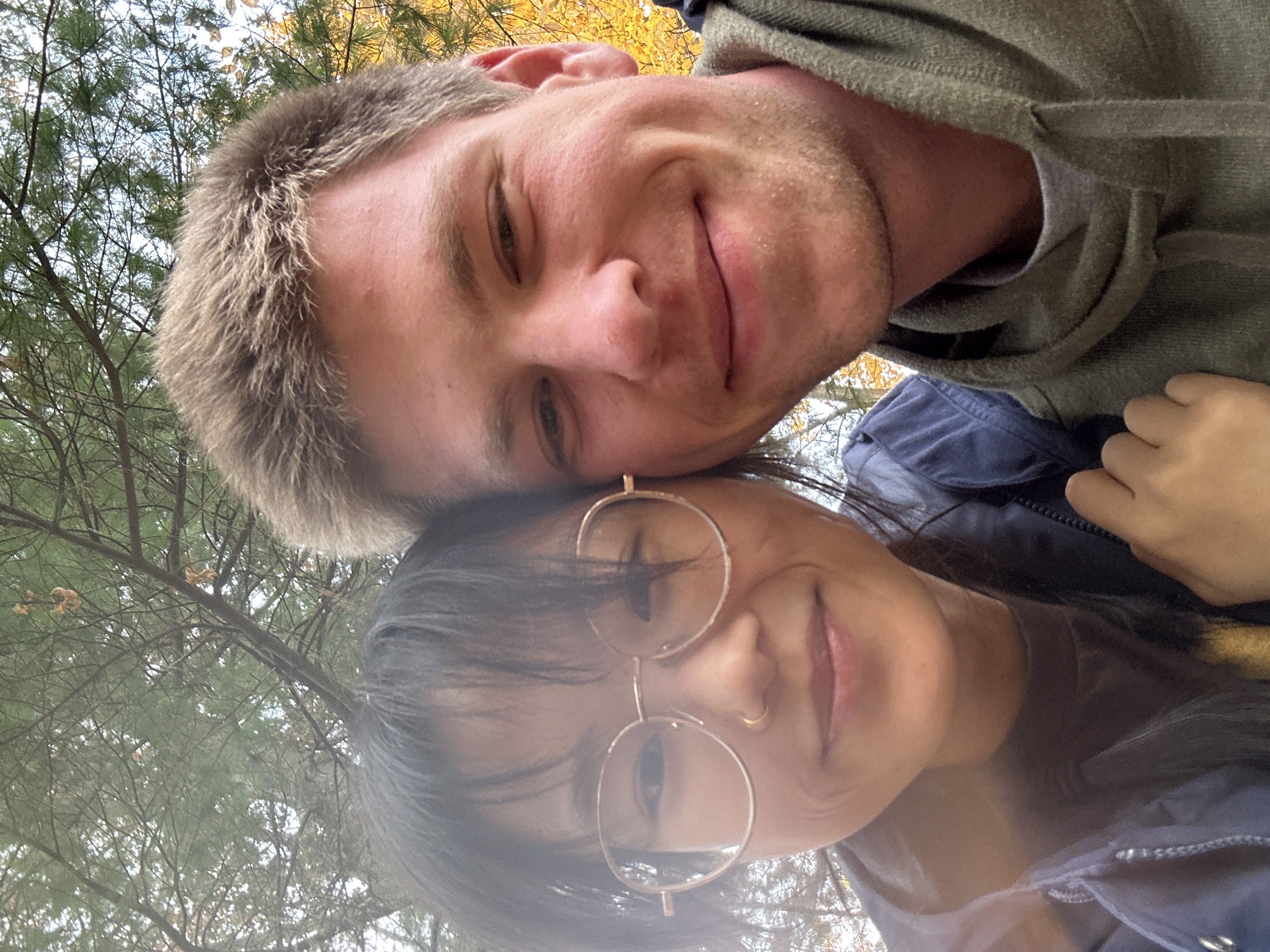
Branche and Margaret, 3, Will you come to my house and play with me?
Hi Branche and Margaret! We are already at your house! Unfortunately, we aren’t visible to humans because of our fairy magic, but you can play with us by building fun homes for us to sleep in at night. Just make sure to use materials that you can find outside like broken sticks, bark, stones, and fallen leaves. We can’t wait to see what you create!
Hadley, 8, How do the leaves change color in the fall?
Hi Hadley! The trees change color because of the weather. As the days get shorter and the temperatures get cooler the pigment that gives leaves their green color breaks down because the trees don't need it anymore! This reveals the other yellow, red, and orange pigments in the leaves. So, these colors have always been there, but have been overpowered by the green chlorophyll. When it transitions from summer to fall to winter, these beautiful colors become unmasked. I love it when the trees change color, red maples have my favorite color change. Check out this blog post to learn more and see some awesome pictures! https://www.natureupnorth.org/justmynature/dadefa22/seasons-change-ode-fall
Juno, 7, Are you real?
Yes of course I'm real! How else would I be answering your question if I wasn't real? You saw my house didn’t you? I’m sorry I wasn’t there when you stopped by, I was out gathering some nuts for dinner! I’m actually thinking of moving, if you could create a home for me out of some sticks, grass, leaves, and any other natural substance you find in your yard I will move in when we move back north next spring! Then I can be even closer to you!
Zenun, 25, Will I ever find true love?
Nature will always love you, but it’s a two-way street! What are you doing for nature? If you treat nature well and love it, it will love you back! To protect and enjoy nature become a community scientist and join Nature Up North’s online community! Nature will always love you when you love it back!
Dani, 21, How do I find more friends to go walking on the trails with?
I would love to go on a walk with you, but I prefer flying. If you attend more nature up north events you can find people that love walking on trails just like you! Here is a link to the website, I have made many friends this way! https://www.natureupnorth.org/events-up-north. Bear in mind that the cold tends to limit the number of events a bit, but it gets busy again in the spring!
Junne, 3, Why is the water so dark?
A very good question Junne! North Country waters are dark because of the trees we have along the banks! Hemlock trees are an evergreen tree that keeps its needles all year long. These trees have something called tannins in their bark that dyes the water a dark brown color! The water in our rivers isn't dirty, it's just tan!
Lucy, 7, I like flowers! Where do they go in the winter?
Oh, Lucy, my dear flower enthusiast! Let me paint you a picture of the magical journey our local flowers embark upon when winter's chill embraces the North Country. When the frosty winds begin to blow across our landscape, our hardy floral friends don't simply vanish—they transform! Like tiny woodland fairies preparing for a long slumber, North Country flowers have their own special ways of weathering our harsh winters.
Some flowers, like the trilliums, tuck themselves away as underground roots and stems. They snuggle down in the frozen earth, protected from the biting cold, dreaming of spring's gentle warmth. Other flowers, such as the fireweed and black-eyed susans, leave their seeds scattered about our meadows and forest edges. These seeds are like little sleeping beauties, waiting for the kiss of spring sunshine to awaken and sprout into new plants!
Jon, 11, Why do some trees turn red, others yellow, and others stay green?
Ah, my curious little nature explorer! The autumn color palette of trees is a magical spectacle, isn't it? Let me explain why we see this beautiful variety in fall foliage.
Different trees turn different colors because of the unique blend of pigments in their leaves: Maples, dogwoods, and some oaks produce a pigment called anthocyanin when the weather turns cool and dry. This pigment creates those stunning reds and crimsons we adore! Birches, poplars, and some maples have carotenoid pigments. These were always present but hidden by the green chlorophyll. When chlorophyll fades, these sunny hues shine through! Check out this blog post to learn more and see some awesome pictures! https://www.natureupnorth.org/justmynature/dadefa22/seasons-change-ode-fall
Linda, Why are the bark of the trees different colors like white, brown, and reddish?
Linda my inquisitive little tree hugger! The variety in tree bark colors is another fascinating aspect of nature's artistry. Let me explain why we see different hues in tree bark. The white color we see in birch trees comes from a substance called betulin. This waxy, water-repellent compound helps protect the tree from sun damage and pests. Brown bark and red back both come from something called a tannin. Tannins are chemical compounds that help protect the tree from fungi and insects. As the bark ages, it often becomes darker creating a dark brown color. In trees with red bark, the tannins are just more concentrated and oxidize, creating the red rusty color. Isn't it wonderful how diverse and beautiful our forest friends can be?
Mercy, 8, Why do the leaves fall?
Good question Mercy! As the days grow shorter and colder, trees prepare for winter by conserving energy. Leaves catch the sun's energy to feed the tree, but as the days get shorter it takes more energy to keep the leaves than they can create. They stop producing chlorophyll (the green color), which makes the leaves change color before falling. Once on the ground, the leaves create a cozy blanket that protects and nourishes the soil, helping the ecosystem prepare for spring!
Emma, 6, Where do the frogs come from?
Frogs begin life as eggs in ponds, wetlands, and streams. After a few weeks, they hatch into tadpoles that look like little beads with a tail swimming around. Then, they slowly develop legs and feet as they grow into frogs. Finally, they lose their tail. Fun fact, frogs freeze solid during the winter and thaw out in the spring for survival. It doesn't hurt them either!
Misha, 7, Where do the fairies come from?
We fairies come from magical places in nature, we thrive in sunlight and care for the forests, meadows and wetlands. We are very small, so you need to be very quiet and look carefully in special places outdoors to try and find us. If you want us to visit you, build us a house out of materials you can find outside. We love homes built with sticks, stones, needles, and other things.

